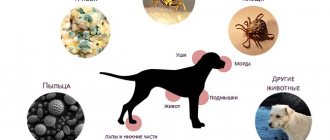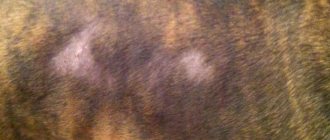The dog was bitten by ticks
Spring, veterinarians warn, is the beginning of the season for the incidence of piroplasmosis, a deadly disease for dogs transmitted by ixodid ticks.
Currently, the disease is recorded throughout almost the entire territory of Russia, where its main carriers are ticks. The territory of Moscow and the Moscow region is also unsafe for piroplasmosis.
Pet owners should take care of prevention, be aware of the signs of disease and first aid measures in case of a tick bite.
Why is a tick bite dangerous for a dog?
The main danger that the ixodid tick poses is its ability to carry serious infections, infecting a large number of animals.
The consequences of a tick bite for a dog can result in serious damage to internal organs due to piroplasmosis, bartonellosis, ehrlichiosis, and even the death of the animal. There is no need to panic, because not all ixodid ticks, but only a tenth of the entire population, are carriers of blood-parasitic infections that destroy red blood cells in the body.
In order to prevent infection, it is necessary to promptly treat the dog against ticks, especially during the peak of parasite activity and in those regions where there are more deciduous shrubs and trees. If a tick is discovered by the owner, it must be removed properly.
You cannot pull the parasite out of the skin, since the tick burrows quite deep into the skin. With a sharp detachment, the oral apparatus of the ixodid tick can remain under the skin and cause the development of an inflammatory process.
It is also important to monitor the condition of the animal for the first 3-4 days after the tick is discovered and removed. When affected by blood parasitic infections, the animal’s condition worsens and intoxication of the body occurs.
The dog may develop febrile conditions, lethargy and severe weakness. The pet refuses to eat and may refuse water.
What diseases can ticks transmit to dogs?
In order to protect your pet from various infections carried by blood-sucking parasites, it is necessary to carry out preventive treatments with special means. Ticks can be carriers not only of blood parasitic infections, but also of all kinds of viruses, bacteria and helminths. Tick vaccinations for dogs will help protect your pet from parasites. At the moment of biting through the skin, the ixodid tick injects a specific secretion containing enzymatic substances that act as an anesthetic, as well as allergens and pathogenic microorganisms. The main infections carried by ixodid ticks are:
- Piroplasmosis is a seasonal disease caused by protozoan parasites. The disease is also called babesiosis from the name of the pathogen cells. Babesia infects red blood cells, gradually causing their destruction. Symptoms of pathology differ depending on the type of pathological process - fulminant, acute or chronic. An accurate diagnosis for the presence of piroplasms in the body is made on the basis of laboratory tests in a veterinary clinic. Treatment of diagnosed piroplasmosis includes the use of specific medications, as well as medications that eliminate symptoms. The animal is prescribed special dietary nutrition, cardio and hepatoprotectors, as well as drugs to maintain the functioning of the renal structures.
- Bartonellosis is an infectious disease caused by pathogenic bacterial microorganisms. In addition to damaging red blood cells, Bartonella infects blood macrophages and destroys the walls of blood vessels. After infection, the pathological process can occur without pronounced symptoms and end with the sudden death of the pet. The chronic form of bartonellosis, in the absence of timely treatment, leads to gradual damage to the cellular structures of the myocardium and brain.
- Lyme disease or borreliosis is an infectious process characterized by a chronic course. The disease is transmitted by the bite of an infected tick. Borreliosis can affect not only pets, but also humans. The insidiousness of the disease lies in its long asymptomatic course for 1-3 months from the onset of infection. Characteristic signs of Lyme disease are fever, swelling in the joints, pain and inflammation of the joints, as well as inflammatory processes in the regional lymph nodes. The pet may begin to limp, failure of the kidney structures develops, and in advanced cases, inflammatory processes in the brain tissue are diagnosed. Treatment consists of prescribing a course of broad-spectrum antibiotics. The duration of treatment depends on the degree of neglect of the pathological process.
- Ehrlichiosis is an infection that affects blood cells (monocytes). The danger lies in the ability of pathogenic microorganisms to spread to all organs, affecting the spleen, hepatorenal and lymphatic systems. There are several stages of pathology. An animal with ehrlichiosis develops iron deficiency anemia, and spontaneous hemorrhages are possible.
- Hepatozoonosis is a disease caused by single-celled protozoan parasites that penetrate the bloodstream and infect white blood cells. When performing a blood test, there is a sharp increase in leukocytes in the blood. Hepatozoonosis is treated with antimicrobial drugs. Symptomatic therapy is also prescribed, aimed at speedy regeneration of the body. It is not possible to completely get rid of hepatozoonosis. Therefore, relapses occur quite often.
What to do if your dog suffers from a tick bite?
The terrible consequences of a bite from a tick infected with piroplasmosis and other infections will not occur if treatment is started on time. The first thing to do is remove the bloodsucker. It is recommended to remove the parasite using the twisting method. To do this, it is better to use tweezers, thread or a ticker - a special device
This should be done with caution, because when pulling out the tick there is a risk that the body will come off the head, which will then be difficult to remove from under the skin without surgical instruments
How to properly remove the parasite?
A professional veterinarian would be better able to handle this task, but it is not always possible to take the dog to the clinic. At home, you can perform removal using the following methods:
With the help of a ticker. The instrument should be in your home veterinary medicine cabinet from April to September. It is equipped with special curved tips that make it easy to unscrew the tick. Tweezers
They need to work carefully. Strong thread. The method requires certain skills
A silk thread is taken, a loop is made in the center, which is thrown over the tick. Having fixed the thread, you need to begin to alternately pull it by one end, then by the other.
If the bloodsucker has not gone deep enough, it makes sense to use an insulin syringe. The tip of the tool must be cut, press the cut against the skin and pull the piston until the insect comes out. When using any method of removing a bloodsucker, you should use gloves.
What to do with a tick?
The removed tick should be placed in a glass jar with a tight-fitting lid and taken to the laboratory. Using specialized equipment, professionals will check whether he is a carrier of a dangerous infection. When a dog is bitten by a tick that is not infected with any diseases, there is no need to treat the pet. All that remains is to observe the bite site for several days.
Do I need to treat the bite site and how?
After removing the tick, it is recommended to treat the remaining mark with an antiseptic. They do this to prevent the inflammatory process. The antiseptic will slow down the development of the disease, which could be transmitted to the animal through a bite. An alcohol solution of iodine, hydrogen peroxide, brilliant green or chlorhexidine bigluconate is used as a disinfectant. If you don’t have a pharmaceutical drug on hand, vodka is suitable for treating the tumor.
What to do next with the dog?
After a tick bite, your dog may immediately develop symptoms of a dangerous disease. She becomes lethargic, apathetic, does not eat or drink. We must not allow her to become ill; she must be taken to the vet immediately. Does your dog refuse food? You need to pour 50 ml of water into his mouth every half hour. The pet needs to be given vitamins B6 and B12 subcutaneously. Injections of drugs should be done with glucose three times a day. This will help the animal hold out until a visit to the doctor and not die in the acute course of the pathology.
If your dog is bitten by an infected tick while walking, it is important to make a correct diagnosis. It is difficult to transport a large dog that is paralyzed due to illness to the hospital
In this case, the owner needs to collect blood from the pet himself.
The animal's ear is wiped with alcohol, a small incision is made with a scalpel in the place where the veins accumulate and glass is applied to it. The blood is dried and placed in a resealable jar. In this form it is delivered to the laboratory. Thanks to the analysis, the doctor will be able to determine what infection the dog has picked up, which will facilitate the process of treatment and rehabilitation.
Ways to protect your animal from parasites
The easiest way to protect your dog from ticks is to inspect his coat and skin after every walk. The peculiarity of insects is that for the first few hours they may not bite the animal, looking for a convenient place, so the chance of getting rid of it without loss is high. To detect a tick, run your hand against the dog's fur, carefully examine it, and feel it. If it has already “sucked in”, you will feel a small, convex ball to the touch. Examine the scalp, neck, ears, and abdomen especially carefully.
Anti-tick drops and sprays
There is no way to constantly examine the dog if the owner goes with it to nature or to the country. To prevent bites, veterinarians have created special preparations that repel arthropods and prevent the risk of infection from a bite. A few days before departure, it is recommended to treat the dog’s neck with Advantix drops - the product lasts for about a month, so it does not require frequent application.
There is no way to constantly examine the dog if the owner goes with it to nature or to the country. To prevent bites, veterinarians have created special preparations that repel arthropods and prevent the risk of infection from a bite. A few days before departure, it is recommended to treat the dog’s neck with Advantix drops - the product lasts for about a month, so it does not require frequent application.
Folk remedies
Experience shows that there are no effective folk remedies against ticks, because insects sense blood well, although there is a method that slightly reduces the risk of a bite. To do this, you need to wash the mammal with tar soap, and then rinse it with a decoction of wormwood. Another way to avoid bites is to sew a light summer jumpsuit and wear it for walks in parks, where there is tall grass and there is a high risk of catching a tick. In addition, your pet should not be allowed to interact with yard dogs.
What types of vectors of dangerous diseases are known in Russia?
Ixodes – this genus includes the species I. Ricinus, Persulcatus. The former can be distinguished by the characteristic shade of the abdomen - orange or light red. The second ones look similar. Parasites can live in green urban areas, parks, squares, as well as in private plots, cemeteries, etc. These insects can transmit borreliosis, babesiosis and infection caused by Bartonella bacilliformis to the animal.
Dermatocentor - includes the species D. reticulatus, which is dangerous because these ticks are carriers of plague, tularemia, brucellosis and other infectious diseases, many of which are easily transmitted to humans.
Haemaphisali - representatives of this genus (for example, H. punctata, sulcata, otophila) are found on all continents and can cause acariasis, Lyme disease, tick-borne encephalitis and other equally dangerous diseases.
Rhipicephalus – These insects are also called the “brown dog tick”. The consequences of their bites are unpredictable - even paralysis. The dog is the main food source for this parasite. If you bring one member of the genus into your house, soon the house will be flooded with a whole brood, which will be much more difficult to cope with. Often such pests crawl into the ears of an animal or person. They become carriers of a disease known as Rickettsia africae (rickettsiosis) and piroplasmosis.
After such a description, the question of whether ticks are dangerous for dogs disappears: it becomes clear that delay can lead to the death of the pet and it is very important not only to start treatment in a timely manner, but also to simply prevent the possibility of infection by removing the insect from the dog in time
Are ticks on dogs dangerous for humans?
We found out whether ticks are dangerous for dogs a little higher, now we will tell you about the danger dog ticks pose to humans and how to protect yourself from this danger. First, we need to clarify that dog scabies mites are not able to live on human skin, so it is impossible to get scabies from a dog. Secondly, demodicosis is a non-contagious disease; it is also not transmitted from dogs to humans.
Only ixodid ticks pose a real danger. A dog can bring them into the house on its fur, and they can attach themselves to a person. If it is an encephalitis tick, a person can become infected with a dangerous disease when removing the tick from a dog with bare hands. In addition to encephalitis, a person can become infected with the following diseases from dog ticks: borreliosis, tularemia, Marseilles fever.
To protect yourself, you need to carefully examine not only the dog, but also yourself after a walk in the fresh air, remove attached parasites from the dog’s body using rubber gloves, and use ultrasonic repellers and repellents.
Symptoms indicating infection with piroplasmosis
Characteristic symptoms for piroplasmosis can individually appear in many diseases with a milder course, so a comprehensive analysis of the pet’s behavior and well-being helps to suspect piroplasmosis in the early stages, when the dog can still be saved with timely treatment.
Symptoms after infection appear in a rapid progression; as the disease progresses, existing ones worsen and new ones are added.
- The first symptoms begin already on the second day after the bite with an increase in temperature to 42 degrees, which is maintained at this level until the onset of the irreversible stage preceding the death of the animal.
- The dog breathes rapidly, its pulse becomes thread-like and frequent.
- The pet loses activity, becomes lethargic, moves little, tries to lie down and do nothing, refuses to play, is reluctant to go for walks, and tries to hide away from its owners so as not to be disturbed.
- The animal loses its appetite, which in itself may not alert the owner. But the fact that a pet turns away from its favorite treat, which it has always begged for before, should cause serious concern.
- After a day or two, vomiting occurs, often with mucus, because by this time the dog is hungry and his stomach is empty. There may be blood in the vomit.
- Vomiting is accompanied by disturbance of stool in the form of diarrhea with possible impurities of blood, the color of feces shifts towards bright yellow or greenish.
- The lips, mouth and eyelids often become red at first and then pale, with a yellowish or grayish tint, but they can immediately turn pale without redness.
- On days 2–4, weakness in the hind legs characteristic of piroplasmosis is observed. The pet moves with difficulty, the gait is constrained, as if it brings suffering to the dog. At this stage, all the total symptoms already indicate the development of an acute stage of a fatal infection.
- On days 3–5, the dog’s urine darkens due to destroyed red blood cells released during urination, and becomes similar to dark beer or coffee. This phase requires urgent resuscitation measures, because it indicates the beginning of irreversible processes.
- If the owner of the sick dog does not take the right steps and does not seek urgent veterinary help, but begins to independently treat the dog with all sorts of folk remedies, the pet will experience complete paralysis after a tick bite 5 - 7 days from the moment of infection, and the animal will inevitably die.
Types of parasites
Many owners have discovered a dried tick or tick eggs on a dog (a photo of tick reproduction on a dog is presented below). Some begin to panic in such cases, while others do not pay much attention to this fact.
The tick itself is not dangerous, and it is not capable of drinking all the blood. However, the bloodsucker is capable of carrying infectious bacteria that, having settled in red blood cells, damage them. Bacteria multiply quite quickly, and in the absence of appropriate treatment measures, in almost 98% of cases the disease leads to the death of the animal.
On a note!
Dog ticks in Russia can be of different types: ear (internal) and demodectic (intradermal) bloodsuckers, but the most dangerous for dogs is the ixodid tick (external).
Ticks on dogs
Bite symptoms
Most owners will not immediately recognize a tick bite on their pet. This is largely due to the fact that the symptoms are similar to other diseases that dogs are susceptible to.
It is important to distinguish parasite bites from diseases such as:
- enteritis;
- leptospirosis;
- plague, as well as some others.
Another significant problem is timely detection. Often, owners discover the disease only when all the symptoms have already begun to appear.
When diagnosing, it is important to take into account: piroplasmosis can be tolerated differently by dogs of different ages and breeds. The following signs indicate that your pet is infected with piroplasmosis:
- loss of appetite, aversion to food;
- decreased activity;
- apathy.
Approximately on days 3-5, new symptoms are added, indicating damage to the pet’s gastrointestinal tract:
- vomiting, mixed with mucus, sometimes “silent”, that is, only the urge without vomiting;
- diarrhea (sometimes), the color is yellow or green;
- change (darkening) in urine color;
- stiffness of the animal's movements.
How can a dog become infected?
Piroplasmas have two types of hosts. The first are considered to be representatives of the canine family, the final ones are ixodid ticks. This is a red-bottomed tick measuring up to 4 mm in a hungry state. Pyroplasmas multiply and develop in their body.
Females are carriers of the disease. They transfer it to eggs, from where larvae with infection emerge. Therefore, at any stage, this pest will infect the pet.
The peak of the disease in dogs occurs at the same time as the period of tick activity. It lasts longer than in humans. Larvae and nymphs almost never bite humans, unlike animals. During this period, signs of pathology appear in pets.
Piroplasmosis is diagnosed in the warm season. It does not end even in the middle of summer, when the larvae and nymphs begin to look for victims. A dog walking on the grass runs the risk of becoming prey. Ticks cling to the fur, then begin to crawl over a convenient area to locate.
Therefore, you should examine your pet after each walk in areas with abundant vegetation. This is important even if the dog has been treated with anti-parasite medication. You need to pay special attention to the head. Also, most often ticks bite a dog in the following places:
- ears;
- groin;
- limbs;
- breast;
- neck.
The tick may also end up near the eye and in other areas where insects are difficult to remove. In this case, it is better not to delay going to the veterinarian.
Even the most proven tick repellent will not guarantee that the disease will not affect the dog. Therefore, during a dangerous period, it is important for owners to be vigilant. If therapy is not started promptly, death may occur.
Prevention of piroplasmosis in dogs: drugs, vaccination, vaccine
To protect against parasites, drops, collars, sprays, and ultrasonic keychains are used. Common brands include Bars, Bravecto, Frontline, Inspector, Chistotel, Advantix, and Advokat. There are usually drops for large and small dog breeds. After treatment with drops, you can wash your dog on the third day. Some owners use all methods at once. This should not be done, because they are toxic and their excess causes poisoning.
Folk remedies are also used as prevention. For example, vodka and vanillin against ticks. Mix 100 ml of the drink with 2 g of vanillin. Leave for seven days and treat the pet. This method is not recommended for puppies. Coconut oil and essential oils (basil, lavender, clove) are also used.
After walking, you need to carefully examine the animal. If the wool is carefully processed, ticks will not remain on it. They die or look for another victim.
There are now two vaccines that are used to protect against piroplasmosis. These are “Nobivak Piro” and “Pirodog”. They form immunity that helps fight pathology. The injection is given twice, after a two-week break. The action lasts six months. If infected, the course of the disease may be milder.
Tick treatment and vaccination are carried out once a year using high-quality preparations. But it is not recommended to purchase various products yourself in pet stores and veterinary pharmacies and carry out prevention of blood-sucking insects at home. In such a case, it is difficult to calculate the optimal dosage, and the quality of the drops and sprays used may leave much to be desired.
As a preventive measure, veterinarians recommend walking only on lawns with mown short grass in the warm season. Ticks love to settle in pine needles, so you should refrain from visiting forests or areas where thujas are planted or wild juniper grows. It is in such places that the likelihood of picking up a tick increases significantly, which will infect the dog with various infectious diseases.
There is no effective vaccination against piroplasmosis, but today there is a fairly wide selection of means to protect against ticks: sprays, collars and drops on the withers.
A spray is enough to protect your “apartment” dog while walking. Sprays “Frontline” from the French company Merial and the Russian “Bars” have proven themselves well. You need to treat your dog with it on the balcony or on the street. If the animal has thick and long hair, it is necessary to make partings and spray the spray into them.
Simply applying a spray is not enough. Wearing rubber gloves, rub the product into the skin. If the spray remains on the fur, there will be no talk of any protection against ticks.
If you are planning a long stay of the dog in nature (in the forest, at the dacha, in the village), it would be advisable to put an insectoacaricidal collar on the animal 2-3 days before the trip. The Kiltix collar from Bayer (Germany) is quite reliable. The size of the collar should correspond to the height and weight of the dog.
When going to the country with your dog, you need to protect it with a tick collar
For those dogs that live in an apartment, but often walk in parks and squares, combined protection is used, however, “overdoing” with the application of various products is very dangerous - the dog may develop allergic reactions and the formation of a new ineffective substance on the animal’s body as a result of mixing several .
Vaccines Pirodog from Merial and Nobivak Piro from Intervet provide weak immunity but can protect a dog from death if infected with piroplasmosis.
Dog in a protective suit on a walk
How to treat piroplasmosis in an animal
If you find one of the symptoms of piroplasmosis in your dog, you should immediately consult a doctor. The sooner a specialist prescribes treatment, the higher the chance of the animal’s future well-being, because even cured pathology can provoke liver and kidney diseases. The first thing to do is to destroy the Babesia that causes the disease. To do this, the doctor injects the dog with a special drug, after which the microorganisms are removed along with the affected red blood cells, and maintenance therapy is also prescribed. After administering the medicine, the dog feels better, usually on the third day.
- What to drink for weight loss - recipes for making drinks at home
- Diet of ballerinas
- Oily fish - beneficial properties and calorie content, how to cook escolar
Ixodid ticks
The most common and most dangerous bloodsucker is called the ixodid tick. This is a small arachnid insect up to 5 mm in size, black, red-brown or brown in color.
The tick is a carrier of such fatal diseases for dogs as piroplasmosis (babesiosis) and borreliosis (Lyme disease).
An animal can become infected while walking in a field, forest or swamp. When examining short-haired dogs, the insect is easily detected. And to find a tick on a long-haired pet, you need to comb it with a fine comb in the direction against the hair.
When examining, special attention should be paid to the stomach, paws, ears and base of the skull - these are the parasite’s favorite places. And by sliding your hand against the fur, you can detect an already attached tick
At this moment, it looks like a bloated pea of gray, pinkish or dirty yellow color.
How to remove a tick from a dog? An embedded bloodsucker can be quickly removed as follows:
- A loop in the form of a “noose” is made from a strong thread. It wraps around the tick’s body at the base of the head and secures itself.
- By turning the loop counterclockwise, we pull out the bloodsucker.
- The wound is treated with brilliant green or iodine. The extracted parasite must be placed in a sealed container and, if the animal becomes ill, sent for research.
Not all ticks are carriers of infections, and their bite is not always dangerous for the animal. But the harmfulness of the parasite cannot be determined without research, so the threat of infection always exists. After removing the insect, the pet's condition should be monitored. Signs of the disease appear within 10 days.
If an infected tick bites a dog, it may have the following symptoms:
- loss of appetite, weakness and lethargy;
- unsteady gait;
- elevated temperature;
- dark color of urine.
If you have at least one symptom, you need to urgently show your dog to a veterinarian. At the clinic, the animal's blood will be taken for analysis to identify the causative agent of the infection. For treatment, the doctor prescribes special medications. To relieve intoxication and support general condition, a complex of vitamins, saline solutions, immunomodulators and cardiac medications are used.
The dog was bitten by a tick: what to do? When bitten by a tick, delay can cost your dog his life. Piroplasmosis develops especially quickly. If measures are not taken in time, the pet may die. Even with successful treatment, some consequences of piroplasmosis can remain with the dog for life. These include anemia, heart failure, and damage to the nervous system.
It is impossible to completely protect your dog from ticks, but following simple rules will reduce the danger to a minimum:
- examining the animal after each walk;
- treating the dog with acaricidal preparations from April to November.
How to remove a tick from a dog
A tick removed in a timely manner is a chance that the animal did not have time to become infected with anything. All parasites found on the dog's body must be removed. This must be done by adhering to the following rules:
- If a tick has attached itself to your pet, forget about the common advice - do not use vegetable oil or gasoline to pre-treat the insect. This will kill the bloodsucker, but at the moment of death he will release the contents of his stomach into the dog’s blood - dangerous infections will occur.
- All you need to remove is tweezers and rubbing alcohol. The body of the parasite and the place where it has attached itself to the skin are moistened with alcohol or its analogue.
- When the alcohol takes effect and the dog’s tick slightly relaxes its proboscis, begin to remove it.
- The parasite is grabbed with tweezers and slowly and carefully twisted counterclockwise. The tweezers should be held parallel to the skin or at a slight angle so as not to damage the bloodsucker's body.
- If the head of the tick remains inside the dog's skin, it is necessary to immediately show the animal to a veterinarian.
After removing the insect, it is submitted for analysis, and the pet is closely monitored in order to notice in time changes in the dog’s behavior after the bite and a possible deterioration in its condition.
Important! Remember that many dangerous diseases transmitted through parasite saliva have a long incubation period.
What does a tick look like?
The size of a hungry tick ranges from 1 to 4 mm, and the color varies from light brown to black. Thanks to this, it becomes almost invisible on the pet’s fur.
The body of the parasite consists of a head, a slightly elongated flattened body (the thorax and abdomen have no anatomical divisions) and four pairs of limbs.
On the back there is a protective chitinous shield that covers the entire body in males, and only the front part in females, allowing the abdomen to expand 10-20 times when filled with blood. This is due to the fact that a hungry female is not able to give birth to full-fledged offspring, so finding a victim is a vital factor for her. But males can live without food, so it is extremely rare to find them on a dog.
Ticks help to stay on the animal’s body:
- microscopic bristles and spines covering the entire body of the parasite and increasing the coefficient of adhesion to the skin and hair of the animal;
- sharp claws on the paws, allowing it to be securely attached to the fur;
- flattened body shape, making it difficult to crush the parasite.
Within 4-6 hours, the tick is actively looking for a place to attach, protected from direct sunlight, with certain temperature and humidity parameters.
When filled with blood, the tick's body enlarges and changes color, becoming bright brown, red or pink, depending on the degree of saturation.
Knowing what a tick looks like, it can be removed from the animal’s body even before the parasite penetrates the skin and begins to feed on blood.
To do this, immediately after a walk, you should conduct a thorough examination of the dog’s body, paying special attention to the area:
- groin;
- scruff;
- anus;
- interdigital folds;
- belly;
- inner surface of the hind limbs;
- ears;
- armpits.
Symptoms and signs
Babesia
1. The incubation period for piroplasmosis is from 1 to 3 weeks. Babesia settle in red blood cells and feed on their contents. When they have eaten everything, they move to the next cage.
The following forms of the disease are distinguished:
- Lightning fast, the animal dies suddenly without clinical symptoms.
- Manifest, characterized by the following signs: after a tick bite, the dog experiences convulsions;
- refusal to eat;
- yellowness of mucous membranes;
- temperature 42°C;
- tachycardia;
- dark brown urine;
- paralysis of the hind limbs.
2. Bartonellosis is characterized by a chronic course. Months after the bite, the following symptoms develop:
- vomiting, diarrhea;
- conjunctivitis;
- myocarditis;
- pathologies of the mucous membranes - rhinitis, stomatitis; gingivitis.
3. Borreliosis develops 3-4 weeks after the bite. The disease is characterized by the following symptoms:
- lameness, joint pain;
- fever;
- tachycardia;
- paresis of limbs;
- convulsions;
- a characteristic symptom is ring-shaped redness after a bite or erythema migrans, which disappears and appears on another part of the body.
4. Ehrlichiosis is characterized by inflammation of blood vessels - vasculitis. Clinical signs are as follows:
- apathy;
- hyperthermia - 41° C;
- purulent rhinitis and conjunctivitis;
- hemorrhages on mucous membranes and non-pigmented skin;
- thrombocytopenia.
Watch the video:
Symptoms and consequences of a tick bite for pets
If a cat or dog is bitten by a tick and it becomes infected, the complications are no less severe than in humans. Therefore, it is necessary to remove the parasite as quickly as possible, and then monitor the well-being of the pet. When pathological symptoms appear, you should immediately contact a veterinarian.
What happens when a tick bites a cat?
As in the case of a person, once on a cat’s body, the parasite quickly moves in search of a convenient place.
Most often, the insect bites cats in the following places:
- Armpits;
- Neck;
- Stomach;
- Behind the ears;
- Groin area;
- Hind legs.
An infected parasite transmits the following dangerous diseases among cats:
- Hemabartonellosis;
- Borreliosis or Lyme disease;
- Piroplasmosis;
- Theileriosis.
If treatment is not timely, infectious processes progress, which leads to the destruction of red blood cells, lymph nodes, bone and brain, and internal organs. Tick bites are especially dangerous for kittens and old cats. These animals have a weakened immune system, so they are more susceptible to dangerous complications than others.
If the following symptoms develop, you should take your animal to the veterinarian as soon as possible:
- Increase in temperature;
- Lack of appetite, sudden weight loss;
- Lethargy, drowsiness;
- Intestinal upset, vomiting;
- Unnatural pallor or yellowness of the mucous membrane;
- Uncharacteristic cat behavior.
Most often, ticks infect cats with the following pathologies:
- Theileriosis. The infection affects most internal organs. Microorganisms live in the blood, rapidly spreading throughout the body. The animal develops acute anemia, jaundice, and problems with respiratory function. Heat. Two weeks after the first signs, the cat dies from complications.
- Hemabartonellosis. The infection causes acute anemia in the cat and reduces immunity. But with timely treatment, the animal recovers completely.
- Tick-borne encephalitis. The infection affects the brain. If not treated in a timely manner, encephalitis develops into chronic meningitis, which is life-threatening for the pet and can result in death.
Consequences of a bite for dogs
It is necessary to remove a tick that has burrowed under the dog’s skin as soon as the parasite is noticed.
After this, it is important to carefully monitor the pet. If the insect is not infected, then the general condition will be normal
The bite site turns slightly red and swells, but in general the dog behaves as usual.
The following symptoms should alert you:
- Increase in temperature;
- Lethargy, increased fatigue;
- Lack of appetite;
- Bad breath;
- Vomit;
- Shortness of breath;
- Yellowness of the eyeballs;
- Convulsions;
- Loss of coordination.
The following diseases are most often transmitted to dogs from ticks:
- Bartonellosis. The disease can manifest itself after several years, and the dog dies suddenly. Sometimes batronellosis is not accompanied by severe symptoms, but more often the animal is bothered by fever, anemia, and rapid weight loss.
- Hepatozoonosis. The disease develops after an adult dog or puppy swallows an insect. There are no symptoms until problems with the functioning of the immune system begin. As soon as the immunity drops, the animal’s condition deteriorates sharply, with fever, severe pain in the joints, and pathological discharge from the eyes.
- Borreliosis. Symptoms develop 1.5 - 2 weeks after the bite. If the female is pregnant, the infection is transmitted to the fetus and the puppies die in utero. According to clinical data, treatment of borreliosis in retrievers and Labradors may not be effective.
- Piroplasmosis. It occurs more often than other diseases. Characteristic symptoms are severe thirst, loss of appetite, lethargy.
If the tick is not contagious, there is no danger to your pet. If the parasite is infected, the infection enters the blood through saliva and then spreads throughout the body. In severe cases, a neurotoxic reaction develops, which causes paralysis. In such situations, the dog loses sensation in the lower extremities.
Yorkies need special protection from dangerous insects. The fact is that treatment of infectious diseases in small dogs is extremely difficult. If the bite still cannot be avoided, you should take your pet to a veterinarian, who will advise what to do next to avoid complications and save the pet’s life.
Drug treatment and consequences
After diagnosing the blood test and parasite, the veterinarian will answer what to do depending on the cause of the disease.
The therapeutic course prescribed for the dog is aimed at:
- detoxification;
- elimination of viruses and bacteria.
Please note that self-treatment is fraught with a number of unpleasant consequences caused by incorrect diagnosis and attempts to cure another disease.
The recovery period lasts up to 5 weeks and includes the use of:
- antiparasitic drugs (azidine, berenil, imizol);
- diuretics, allowing you to remove toxins;
- hemostatic agents;
- vitamins;
- drugs to support the liver and heart;
- glucose droppers;
- blood transfusions;
- antibacterial treatments for purulent inflammation.
Please note that of all the diseases discussed, only encephalitis, which causes rapid damage to the central nervous system, cannot be treated. The only solution to alleviate the suffering of an animal is euthanasia.
Types of ticks
Any owner shudders at the thought of fleas or ticks crawling on their pet. Regular prevention protects dogs, but does not guarantee that the parasite will not live on your pet for some time.
] preventive agents [/anchor] openly say that ticks on a treated dog die within 48 hours. If the treatment was carried out more than a month ago or the parasite is resistant to the drug, prevention may not be effective. Recently, cases have become more frequent when live ticks and fleas resistant to fepronil are found on a treated dog.
The conclusion is obvious: even if you adhere to the rules of regular prevention, you need to know the types of ticks that can be found on a dog. You should not ignore daily inspections, especially during the period when parasites are active, that is, in early spring and autumn.











